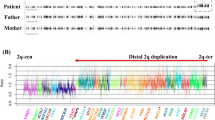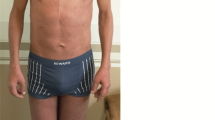Abstract
Congenital generalized hypertrichosis (CGH) is a rare, fully penetrant X–linked dominant trait previously described in a single, multigenerational Mexican family. CGH is a visually striking phenotype characterized by excessive facial and upper torso hair in males and by less severe asymmetric hairiness in females. We have found significant evidence for linkage with several markers from the long arm of the X chromosome. Recombinant chromosomes place the CGH gene within a 22 cM interval between DXS425 and DXS1227 in Xq24–Xq27.1. The localization of a gene for CGH represents the first step towards the isolation of genes involved in hair growth pattern, particularly those involved in restriction of areas in humans.
This is a preview of subscription content, access via your institution
Access options
Subscribe to this journal
Receive 12 print issues and online access
$209.00 per year
only $17.42 per issue
Buy this article
- Purchase on Springer Link
- Instant access to full article PDF
Prices may be subject to local taxes which are calculated during checkout
Similar content being viewed by others
References
Olsen, E.A. in Disorders of Hair Growth: Diagnosis and treatment (ed. Olsen, E.A.) 315–333 (McGraw-Hill, New York, 1994).
Danforth, C.H. Studies on hair. Arch. Dermatol. Syphilol. 11, 804–821 (1925).
Baumeister, F.A.M., Egger, J., Schildhauer, M.T. & Stengel-Rutkowski, S. Ambras syndrome: delineation of a unique hypertrichosis universalis congenita and association with a balanced pericentric inversion (8) (p11. 2; q22). Clin. Genet. 44, 121–128 (1993).
Felgenhauer, W.R. Hypertrichosis lanuginosa universalis. J. Génét. Hum. 17, 1–44 (1969).
Macias-Flores, M.A. et al. A new form of hypertrichosis inherited as an X-linked dominant trait. Hum. Genet. 66, 66–70 (1984).
Happle, R. Mosaicism in human skin. Arch. Dermatol. 129, 1460–1470 (1993).
McKusick, V.A., Mendelian Inheritance in Man. (Johns Hopkins University Press, Baltimore, 1994).
Weeks, D.E., Ott, J. & Lathrop, G.M. SLINK: a general simulation program for linkage analysis. Am. J. hum. Genet. 47, A204 (1990).
Ott, J. Analysis of Human Genetic Linkage (The Johns Hopkins University Press, Baltimore, 1988).
Gyapay, G. et al. The 1993–94 Généthon human genetic linkage map. Nature Genet. 7, 246–339 (1994).
Weissenbach, J. et al. A second-generation linkage map of the human genome. Nature 359, 794–801 (1992).
Willard, H.F. et al. Report of the Fifth International Workshop on Human X Chromosome Mapping 1994. Cytogenet. Cell Genet. 67, 296–328 (1994).
Upadhyaya, M. et al. Localisation of the gene for Hunter syndrome on the long arm of X chromosome. Hum. Genet. 74, 391–398 (1986).
Donnelly, A. et al. A linkage map of microsatellite markers on the human X chromosome. Genomics 20, 363–370 (1994).
Fuchs, E. & Byrne, C. The epidermis: rising to the surface. Curr. Opin. Genet. Devel. 4, 725–736 (1994).
Hardy, M.H. The secret life of the hair follicle. Trends Genet. 8, 55–61 (1992).
Duggins, O.H. & Trotter, M. in The growth, replacement, and types of hair (ed. Minter, R.W.) 569–575 (Ann. New York Acad. Sci., New York, 1951).
Garn, S.M. in The growth, replacement, and types of hair (ed. Miner, R.W.) 498–507 (Ann. New York Acad. Sci., New York, 1951).
Reynolds, E.L. in The growth, replacement, and types of hair (ed. Miner, R.W.) 576–584 (Ann. New York Acad. Sci., New York, 1951).
Montagna, W. & Ellis, R.A. The biology of hair growth (Academic Press, New York, 1958).
Green, M.R., Phil, D. & Couchman, J.R. Distribution of epidermal growth factor receptors in rat tissues during embryonic skin development, hair formation, and the adult hair growth cycle. J. invest. Dermatol. 83, 118–123 (1984).
Lyons, K.M., Pelton, R.W. & Hogan, B.L.M. Organogenesis and pattern formation in the mouse: RNA distribution patterns suggest a role for Bone Morphogenetic Protein 2A (BMP-2A). Development 109, 833–844 (1990).
Blessing, M., Nanney, L.B., King, L.E., Jones, C.M. & Hogan, B.L.M. Transgenic mice as a model to study the role of TGF-beta-related molecules in hair follicles. Genes Dev. 7, 204–215 (1993).
Hebert, J.M., Rosenquist, T., Gotz, J. & Martin, G.R. FGF5 as a regulator of the hair growth cycle: Evidence from targeted and spontaneous mutations. Cell 78, 1017–1025 (1994).
Beighton, P. Congenital hypertrichosis lanuginosa. Arch. Dermatol. 101, 669–672 (1970).
Freire-Maia, N. et al. Hypertrichosis lanuginosa in a mother and son. Clin. Genet. 10, 303–306 (1976).
Winter, G.B. & Simpkiss, M.J. Hypertrichosis with hereditary gingival hyperplasia. Arch. Dis. Child. 49, 394–399 (1974).
McKusick, V.A. The mucopolysaccharidoses. Herit. Dis. Conn. Tiss. 521–686 (1972).
Jackson, L., Kline, A.D., Barr, M.A. & Koch, S. de Lange syndrome: A clinical review of 310 individuals. Am. J. med. Genet. 47, 940–946 (1993).
Haspelslagh, M., Fryns, J.P. & vanden Berghe, H. The Coffin-Siris syndrome: report of a family and further delineation. Clin. Genet. 26, 374–378 (1984).
Cantu, J.M., Garcia-Cruz, D., Sanchez-Corona, J., Hernandez, A. & Nazara, Z. A distinct osteochondrodysplasia with hypertrichosis-individualization of a probable autosomal recessive entity. Hum. Genet. 60, 36–41 (1982).
Janaki, V.R., Premalatha, S., Rao, N.R. & Thambiah, A.S. Lawrence-Seip syndrome. Br. J. Dermatol. 103, 693–696 (1980).
Schinzel, A. & Giedion, A. A syndrome of severe midface retraction, multiple skull anomalies, clubfeet, and cardiac and renal malformations in sibs. Am. J. med. Genet. 1, 361–375 (1978).
Gorlin, R.J., Chaudhry, A.P. & Moss, M.L. Craniofacial hysostosis, patent ductus arteriosus, hypertrichosis, hypoplasia of labia majora, dental and eye anomalies: A new syndrome? J. Pediatr. 56, 778–785 (1960).
Diseases of the hair and scalp (eds Rook, A. & Dawber, R.) 256–282 (Blackwell Scientific Publications, London, 1991).
Cantu, J.M. & Ruiz, C., On Atavisms and atavistic genes. Ann. Genet. 28, 141–142 (1985).
Barth, J.H., Wilkinson, J.D. & Dawber, R.P.R. Prepubertal hypertrichosis: normal or abnormal? Arch. Dis. Child. 63, 666–668 (1988).
Cellini, A. & Offidani, A. Familial supernumerary nipples and breasts. Dermatology 185, 56–58 (1992).
Rampen, F.H.J. Naevocytic naevi as an atavism; their relationship to melanoma risk. Med. Hypotheses 27, 71–75 (1988).
Anderson, M.A. & Gusella, J.R. The use of cyclosporin A in establishing EBV-transformed human lymphoblastoid cell lines. In Vitro 20, 856–858 (1984).
Faiyaz-ul-Haque, M. et al. Mapping of the gene for X-chromosomal split-hand/split-foot anomaly to Xq26–q26.1. Hum. Genet. 91, 17–19 (1993).
Lupski, J.R. et al. DNA duplication associated with Charcot-Marie-Tooth disease type 1A. Cell 66, 219–232 (1991).
Patel, P.I. et al. Isolation of a marker linked to the Charcot-Marie-Tooth disease type 1A gene by differential Alu-PCR of human chromosome 17-retaining hybrids. Am. J. hum. Genet. 47, 926–934 (1990).
Lathrop, G.M., Lalouel, J.M., Julier, C. & Ott, J. Multilocus linkage analysis in humans: detection of linkage and estimation of recombination. Am. J. hum. Genet. 37, 482–498 (1985).
Cottingham, R.W., Idury, R.M. & Schaffer, A.A. Faster sequential genetic linkage computations. Am. J. hum. Genet. 53, 252–263 (1993).
Author information
Authors and Affiliations
Rights and permissions
About this article
Cite this article
Figuera, L., Pandolfo, M., Dunne, P. et al. Mapping of the congenital generalized hypertrichosis locus to chromosome Xq24–q27.1. Nat Genet 10, 202–207 (1995). https://doi.org/10.1038/ng0695-202
Received:
Accepted:
Issue Date:
DOI: https://doi.org/10.1038/ng0695-202
This article is cited by
-
Congenital generalized hypertrichosis: the skin as a clue to complex malformation syndromes
Italian Journal of Pediatrics (2015)
-
Genetisch bedingte Haarerkrankungen
Der Hautarzt (2013)
-
Genetics of Structural Hair Disorders
Journal of Investigative Dermatology (2012)
-
The Evo-Devo Puzzle of Human Hair Patterning
Evolutionary Biology (2010)



